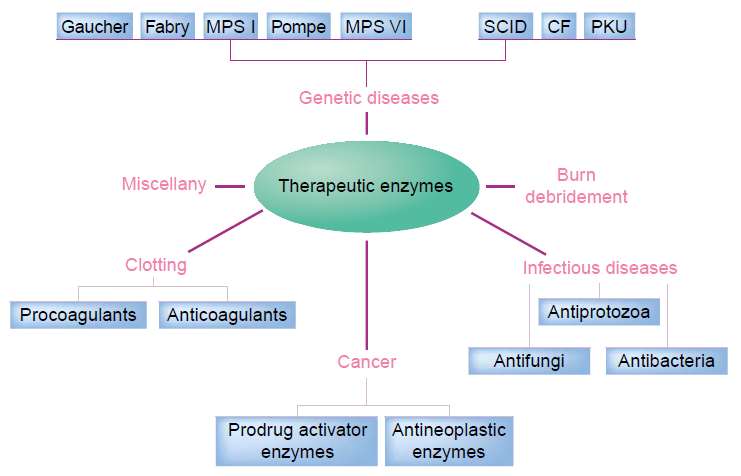Application of Enzymes in the Treatment of Diseases
Enzymes used as drugs have two important characteristics, which are different from traditional drugs. Firstly, unlike drugs they bind and act on their targets with great affinity. Secondly, they are highly specific and act as catalyst to convert multiple target molecules to the desired products. These two features make enzymes specific and potent drugs that can accomplish therapeutic biochemistry in the body that small molecule cannot.
The concept of the therapeutic enzyme has been around for at least 40 years. For example, a therapeutic enzyme was described as part of replacement therapies for genetic deficiencies in the 1960s. In 1987, the first recombinant enzyme drug, Activase® (alteplase; recombinant human tissue plasminogen activator), was approved by the Food and Drug Administration (FDA). This ‘clot-buster’ enzyme is used for the treatment of heart attacks caused by the blockage of a coronary artery by a clot. In 1990, Adagen®, a form of bovine adenosine deaminase (ADA) treated with polyethylene glycol (PEG) was approved to treat patients afflicted with a type of severe combined immunodeficiency disease (SCID), which is caused by the chronic deficiency of ADA.
 Figure 1. Therapeutic enzymes are used in the treatment of a variety of disorders and diseases. (Vellard M. 2003)
Figure 1. Therapeutic enzymes are used in the treatment of a variety of disorders and diseases. (Vellard M. 2003)
Enzymes for the Treatment of Inherited Diseases
Adagen® (pegadamase bovine), used for the treatment of SCID, represents the first successful application of an enzyme therapy for an inherited disease. The enzyme ADA cleaves the excess adenosine present in the circulation of these patients and reduces the toxicity to the immune system of the elevated adenosine levels. Ceredase® (alglucerase injection) for the treatment of Gaucher disease, a lysosomal storage disease (LSD), was the first enzyme replacement therapy in which an exogenous enzyme was targeted to its correct compartment within the body. Recombinant DNA technology subsequently allowed the more efficient production of a glucocerobrosidase, Ceredase® (imiglucerase), which was approved in 1994. This medical, as well as financial, success has paved the way for other enzyme therapies, in particularly those for other LSDs. Enzyme replacement therapies for at least three mucopolysaccharide (MPS) storage disorders (a subgroup of LSD) are currently under investigation. A Phase III clinical trial of Aldurazyme® (laronidase), an enzyme replacement therapy for MPS I, was recently completed and is awaiting approval in the US and Europe (see Update). This LSD is characterized by a deficit in α-L-iduronidase.
Enzymes for the Treatment of Infectious Diseases
Lysozyme has been used as a naturally occurring antibacterial agent in many foods and consumer products, because of its ability to break carbohydrate chains in the cell wall of bacteria. Lysozyme has also been shown to possess activity against HIV, as has RNase A and urinary RNase U, which selectively degrade viral RNA opening some exciting possibilities for the treatment of HIV infection. Other naturally occurring antimicrobial agents are the chitinases. As an element of the cell wall of various pathogenic organisms, including fungi, protozoa and helminths, chitin is a good target for antimicrobials.
Enzymes for the Treatment of Cancer
Recent studies have shown that PEGylated arginine deaminase, an arginine-degrading enzyme, can inhibit human melanoma and hepatocellular carcinomas, which are auxotrophic for arginine owing to a lack of arginosuccinate synthetase activity. Recently, another PEGylated enzyme, Oncaspar® (pegaspargase), already in use in the clinic, has shown better results for the treatment of children with newly diagnosed standard-risk acute lymphoblastic leukemia than the native, bacterial asparaginase.
Antibody-directed enzyme prodrug therapy (ADEPT) illustrates a further application of enzymes as therapeutic agents in cancer. A monoclonal antibody carries an enzyme specifically to cancer cells where the enzyme activates a prodrug, destroying cancer cells but not normal cells. This approach is being utilized to discover and develop a class of cancer therapeutics based on tumor-targeted enzymes that activate prodrugs. The targeted enzyme prodrug therapy (TEPT) platform, involving enzymes with antibody-like targeting domains, will also be used in this effort.
Reference
- Vellard M. The enzyme as drug: application of enzymes as pharmaceuticals [J]. Current opinion in biotechnology, 2003, 14(4): 444-450.
Related Services
Related Products
Enzymes for Diagnostic and Bioanalysis
Enzymes for Oncology and Thrombus Treatment
To discuss more service details, please contact us.